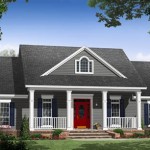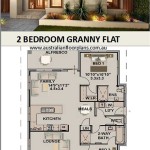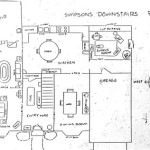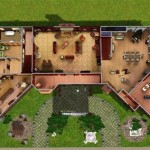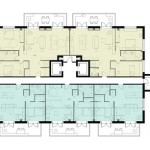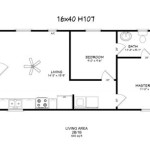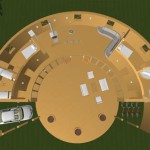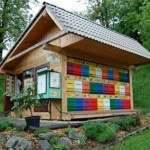Spanish Floor Plans With Courtyard, Balcony, and Designer Touches
Spanish-style architecture, with its roots deeply embedded in the Iberian Peninsula, has captivated homeowners for centuries. The style, characterized by its use of stucco walls, red tile roofs, arched doorways, and wrought iron details, evokes a sense of timeless elegance and warmth. Modern iterations of Spanish floor plans often incorporate desirable features like central courtyards and balconies, meticulously designed to enhance both the aesthetic appeal and functionality of the living space. Designer input is crucial in seamlessly blending these elements to create a harmonious and luxurious home.
This architectural style prioritizes indoor-outdoor living, maximizing natural light and ventilation. The courtyard serves as a focal point, providing a private and tranquil oasis within the home. Balconies, strategically positioned, offer panoramic views and additional outdoor space for relaxation or entertainment. The integration of these features requires careful planning and consideration of factors such as climate, site orientation, and the homeowner's lifestyle. Designers play a pivotal role in ensuring that these elements are not only aesthetically pleasing but also functional and sustainable.
The Allure of the Central Courtyard
The central courtyard is a defining feature of many Spanish-style homes. It is more than just an outdoor space; it functions as an extension of the interior living areas. This enclosed space offers privacy, shelter from the elements, and a connection to nature. Traditionally, courtyards were used for a variety of purposes, including entertaining, dining, and even as a safe space for children to play. In modern Spanish floor plans, the courtyard often serves as a central gathering place, a tranquil retreat, or a lush garden.
The design of the courtyard can vary significantly depending on the homeowner's preferences and the overall architectural style of the house. Some courtyards feature elaborate fountains, while others are adorned with lush greenery and flowering plants. Outdoor kitchens, fireplaces, and comfortable seating areas are common additions, transforming the courtyard into a versatile outdoor living space. The use of natural materials, such as stone, brick, and wood, further enhances the courtyard's connection to the surrounding environment.
The courtyard's impact extends beyond its immediate boundaries. The design often influences the layout of the surrounding rooms. Large windows and doors facing the courtyard allow natural light to flood the interior spaces, creating a bright and airy atmosphere. The courtyard also serves as a visual focal point from various vantage points within the home, enhancing the overall sense of spaciousness and tranquility. Furthermore, proper planning helps with natural ventilation, which cools the house and saves energy.
Balconies: Extending the Living Space Upward
Balconies are another essential element of Spanish-style architecture, offering both aesthetic appeal and functional benefits. These elevated outdoor spaces provide panoramic views, allow for natural ventilation, and create a seamless transition between indoor and outdoor living. Balconies can be designed in a variety of styles, ranging from simple wrought-iron railings to elaborate covered verandas.
The placement of balconies is a critical consideration in the design process. Strategically positioned balconies can capture prevailing breezes, providing natural cooling and ventilation. They can also offer stunning views of the surrounding landscape, enhancing the aesthetic appeal of the home. In many Spanish-style homes, balconies are located off bedrooms or living areas, providing private outdoor retreats for relaxation and contemplation. These areas also provide a place to grow plants that require more natural sunlight.
The design of the balcony should complement the overall architectural style of the house. Wrought-iron railings are a common feature, adding a touch of elegance and sophistication. Other design elements, such as arched openings, decorative tiles, and potted plants, can further enhance the balcony's visual appeal. The choice of materials is also important, with durable and weather-resistant options being preferred to ensure longevity. The size can vary, with some just being enough for standing while others are wide enough to place furniture.
The Designer's Role: Integrating Aesthetics and Functionality
The successful integration of courtyards and balconies into Spanish floor plans requires the expertise of a skilled designer. The designer's role extends beyond aesthetics; they must also consider functionality, sustainability, and the homeowner's specific needs and preferences. Designers can work with architects to ensure that the courtyard and balcony designs seamlessly integrate into the overall architectural framework.
One of the designer's primary responsibilities is to create a cohesive and harmonious design that reflects the homeowner's individual style. They will work closely with the homeowner to understand their lifestyle, preferences, and budget. Based on this information, the designer will develop a design concept that incorporates the desired features and elements, while remaining true to the principles of Spanish-style architecture.
The design process typically involves several stages, including conceptual design, schematic design, and construction documentation. During the conceptual design phase, the designer will explore different design options and develop preliminary sketches and renderings. In the schematic design phase, the designer will refine the design concept and develop detailed floor plans and elevations. The construction documentation phase involves creating detailed drawings and specifications that will be used by the contractor to build the home. Each stage is crucial in ensuring the final product matches the original vision.
A key aspect of the designer's role is to ensure that the courtyard and balcony designs are functional and sustainable. They will consider factors such as climate, site orientation, and energy efficiency when selecting materials and designing the layout. For example, they may recommend using drought-tolerant plants in the courtyard to conserve water, or incorporating passive solar design principles to reduce energy consumption. They may also suggest the use of eco-friendly materials and construction techniques to minimize the environmental impact of the project.
Furthermore, the designer will be responsible for coordinating with other professionals involved in the project, such as architects, engineers, and contractors. They will ensure that the design is technically feasible and that it complies with all applicable building codes and regulations. Effective communication and collaboration are essential to ensure that the project is completed on time and within budget. The designer aims to make the process smooth and efficient for the homeowner.
The integration of smart home technology is another area where designers can add value to Spanish floor plans. Smart home systems can automate tasks such as lighting, temperature control, and security, enhancing the convenience and comfort of the living space. Designers can incorporate these technologies seamlessly into the design, ensuring that they are both functional and aesthetically pleasing. For example, they may recommend installing smart lighting systems that can be controlled remotely or integrating a security system with the home's existing architectural elements.
Ultimately, the designer's goal is to create a Spanish-style home that is both beautiful and functional. By carefully considering the homeowner's needs and preferences, and by integrating elements such as courtyards, balconies, and smart home technology, designers can create living spaces that are truly exceptional. The thoughtful design ensures the house reflects the homeowner's personality and provides a comfortable and enjoyable living experience for years to come. The final product is a testament to the designer's skill and expertise.
In addition to the aforementioned aspects, designers typically manage the interior design of the house as well. This includes everything from color palettes to furniture selection, ensuring the entire house has a cohesive theme. This theme is carefully planned in accordance with the homeowner's lifestyle and preferences.

Tuscan Style House Plan 4480 Villa Roberto

Home Plan Casoria Tuscan House Plans Design Sater Collection

Small Spanish Contemporary House Plan 61custom Modern Plans

Mexican Hacienda Floorplan Love The Layout

Home Plan Casoria Tuscan House Plans Design Sater Collection

Home Plan Casoria Tuscan House Plans Design Sater Collection

Plan W33047zr Narrow Lot Florida Mediterranean Green Net Zero Ready Spanish House Plans Home Designs

Mediterranean Home With 5 Bdrms 3327 Sq Ft Floor Plan 108 1370

Beautiful Examples Of Modern Spanish Mediterranean Homes Edward George

Spanish Colonial Home Plans Sater Design Collection

